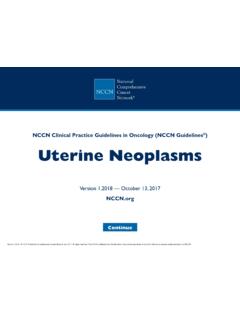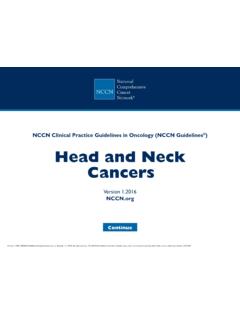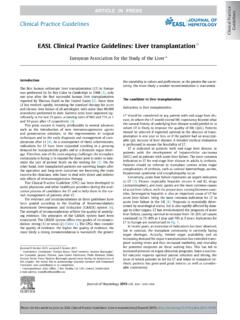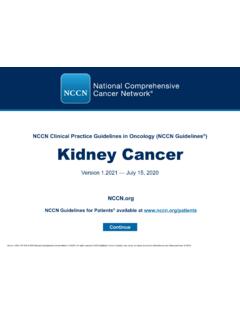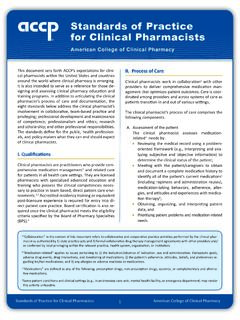Transcription of REVIEW Open Access Canadian clinical practice guidelines ...
1 REVIEWOpen AccessCanadian clinical practice guidelines for themanagement of anxiety, posttraumatic stress andobsessive-compulsive disordersMartin A Katzman1*, Pierre Bleau2, Pierre Blier3, Pratap Chokka4, Kevin Kjernisted5, Michael Van Ameringen6,the Canadian Anxiety guidelines Initiative Group on behalf of the Anxiety Disorders Association of Canada/Association Canadienne des troubles anxieux and McGill UniversityAbstractBackground:Anxiety and related disorders are among the most common mental disorders, with lifetimeprevalence reportedly as high as 31%. Unfortunately, anxiety disorders are under-diagnosed and :These guidelines were developed by Canadian experts in anxiety and related disorders through aconsensus process. Data on the epidemiology, diagnosis, and treatment (psychological and pharmacological) wereobtained through MEDLINE, PsycINFO, and manual searches (1980 2012). Treatment strategies were rated onstrength of evidence, and a clinical recommendation for each intervention was made, based on global impressionof efficacy, effectiveness, and side effects, using a modified version of the periodic health examination :These guidelines are presented in 10 sections, including an introduction, principles of diagnosis andmanagement, six sections (Sections 3 through 8) on the specific anxiety-related disorders (panic disorder,agoraphobia, specific phobia, social anxiety disorder, generalized anxiety disorder, obsessive-compulsive disorder,and posttraumatic stress disorder), and two additional sections on special populations (children/adolescents,pregnant/lactating women, and the elderly) and clinical issues in patients with comorbid :Anxiety and related disorders are very common in clinical practice , and frequently comorbid withother psychiatric and medical conditions.
2 Optimal management requires a good understanding of the efficacy andside effect profiles of pharmacological and psychological and related disorders are among the most com-mon of mental disorders. Lifetime prevalence of anxietydisorders is reportedly as high as 31%; higher than thelifetime prevalence of mood disorders and substance usedisorders (SUDs) [1-5]. Unfortunately, anxiety disordersare under-diagnosed [6] and under-treated [5,7,8].These guidelines were developed to assist clinicians,including primary care physicians and psychiatrists, aswell as psychologists, social workers, occupational thera-pists, and nurses with the diagnosis and treatment ofanxiety and related disorders by providing practical,evidence-based recommendations. This guideline docu-ment is not focused on any individual type of clinicianbut rather on assessing the data and making recommen-dations. Subsequent user friendly tools and otherinitiatives are guidelines include panic disorder, agoraphobia,specific phobia, social anxiety disorder (SAD), generalizedanxiety disorder (GAD), as well as obsessive-compulsivedisorder (OCD), and posttraumatic stress disorder(PTSD).
3 Also included are brief discussions of clinicallyrelevant issues in the management of anxiety and relateddisorders in children and adolescents, women who arepregnant or lactating, and elderly patients, and patientswith comorbid conditions.* Correspondence: of Psychiatry, University of Toronto, Toronto, ON, M5S 1A1,CanadaFull list of author information is available at the end of the articleKatzmanet Psychiatry2014,14(Suppl 1):S1 2014 Katzman et al; licensee BioMed Central Ltd. This is an Open Access article distributed under the terms of the CreativeCommons Attribution License ( ), which permits unrestricted use, distribution, andreproduction in any medium, provided the original work is properly cited. The Creative Commons Public Domain Dedication waiver( ) applies to the data made available in this article, unless otherwise guidelines are based on a thorough REVIEW ofthe current literature and were developed by a panel ofCanadian experts in anxiety and related disordersthrough a consensus process.
4 Data on the epidemiology,diagnosis, and treatment (psychological and pharmacolo-gical) were obtained through MEDLINE searches ofEnglish language citations (1980 2012), using searchterms encompassing the specific treatments and specificanxiety and related disorders. These searches were supple-mented with data from PsycINFO and manual searches ofthe bibliographies of efficacy studies, meta-analyses, andreview articles. Treatment strategies were rated onstrength of evidence for the intervention (Table 1). A clini-cal recommendation for each intervention was then made,based on global impression of efficacy in clinical trials,effectiveness in clinical practice , and side effects, using amodified version of the periodic health examination guide-lines (Table 2).The guidelines were initiated prior to the introductionof the American Psychiatric Association s (APA) fifth edi-tion of the Diagnostic and Statistical Manual of MentalDisorders (DSM-5) and the committee was sensitive topotential changes to the nosology of anxiety and relateddisorders and its impact on the guidelines .
5 However, itwas agreed that, since the evidence for treatment is basedon studies using DSM-IV criteria (or earlier), the intro-duction of the DSM-5 would not fundamentally alter theevidence and recommendations at this time. Whetherusing DSM-5 diagnostic criteria for the inclusion patientsin clinical trials in the future will have an impact on out-comes, remains to be panel of Canadian experts in anxiety and relateddisorders responsible for the development of theseguidelines via consensus process included 10 psychia-trists and seven psychologists who were organized intosubpanels based on their expertise in particular anxietyor related disorders as well as in treating specific patientpopulations. Preliminary treatment recommendationsand the evidence upon which they had been based werereviewed at a meeting of the panel in December 2012;subsequently, draft guidelines were prepared by the sub-panels which were then circulated to the entire groupfor consensus ratification during 2013.
6 Preliminaryrecommendations were also presented to the Canadianpsychiatric community for input in September 2012 atthe Canadian Psychiatric Association annual guidelines are presented in 10 sections, the firstof which is this introduction. In the following section, theprinciples of diagnosis and management of anxiety andrelated disorders are covered. That section provides anoverview of the differential diagnoses associated withanxiety and related disorders in general, discusses issuesthat affect all anxiety disorders, and presents the generaladvantages and disadvantages of psychological treatmentand pharmacotherapy options. In the subsequent six sec-tions (Sections 3 through 8), the specific diagnosis andmanagement of the individual anxiety and related disor-ders (panic disorder, specific phobia, SAD, OCD, GAD,and PTSD) are reviewed and recommendations are madefor psychological and pharmacological treatments. Sec-tion 9 discusses issues that may warrant special attentionpertaining to anxiety and related disorders in childrenand adolescents, pregnant or lactating women, and theelderly.
7 The last section of these guidelines addressesclinical issues that may arise when treating patients withanxiety and related disorders who are also diagnosedwith comorbid psychiatric conditions such as majordepressive disorder (MDD), bipolar disorder, or otherpsychoses, and attention deficit/hyperactivity disorder(ADHD), or medical comorbidities, such as pain syn-dromes, cardiovascular disease, and of diagnosis and management ofanxiety and related disordersEpidemiologyPrevalence and impactAnxiety and related disorders are among the most com-mon mental disorders, with lifetime prevalence rates ashigh as 31% [1-5] and 12-month prevalence rates ofabout 18% [3,4]. Rates for individual disorders varywidely. Women generally have higher prevalence ratesTable 1 Levels of evidence1 Meta-analysis or at least 2 randomized controlled trials (RCTs) thatincluded a placebo condition2At least 1 RCT with placebo or active comparison condition3 Uncontrolled trial with at least 10 subjects4 Anecdotal reports or expert opinionLevels of evidence do not assume positive or negative or equivocal results,they merely represent the quality and nature of the studies that have 1 and Level 2 evidence refer to treatment studies in which randomizedcomparisons are available.
8 Recommendations involving epidemiological or riskfactors primarily arise from observational studies, hence the highest level ofevidence for these is usually Level 3. Recommendations, such as principles ofcare, reflect consensus opinion based on evidence from various data sources,and therefore are primarily Level 4 2 Treatment recommendation summaryFirst-lineLevel 1 or Level 2 evidence plus clinical support forefficacy and safetySecond-lineLevel 3 evidence or higher plus clinical support forefficacy and safetyThird-lineLevel 4 evidence or higher plus clinical support forefficacy and safetyNotrecommendedLevel 1 or Level 2 evidence for lack of efficacyKatzmanet Psychiatry2014,14(Suppl 1):S1 2 of 83for most anxiety disorders, compared with men [4,5,9].Anxiety and related disorders are associated with anincreased risk of developing a comorbid major depres-sive disorder [10-12].Anxiety and related disorders put a significant burdenon patients and their family members [13].
9 They areassociated with substantial functional impairment, whichincreases as the severity of anxiety [14] or the number ofcomorbid anxiety disorders increases [7,15]. In addition,studies have demonstrated quality of life impairments inpatients with various anxiety and related disorders[16,17]. Anxiety has a considerable economic impact onsociety as well, being associated with greater use of healthcare services [5,18] and decreased work productivity[18,19].Importantly, studies report that about 40% of patientsdiagnosed with anxiety and related disorder areuntreated [5,7].Suicide riskIn large surveys, anxiety and related disorders wereindependently associated with a significant timesincreased risk of suicide attempts [20-23]; however, dataare conflicting as to whether the risk is moderated bygender [20,23]. Increased risk of suicide attempts orcompleted suicide has been reported for patients withpanic disorder, PTSD [20,24], and GAD [24], even inthe absence of a comorbid mood disorder.
10 These dataindicate that patients with an anxiety disorder warrantexplicit evaluation for suicide risk. The presence of acomorbid mood disorder significantly increases the riskof suicidal behavior [22,25].Initial assessment of patients with anxietyThe management of patients presenting with anxietysymptoms should initially follow the flow of the fivemain components outlined in Table for anxiety and related symptomsAnxiety and related disorders are generally characterizedby the features of excessive anxiety, fear, worry, and avoid-ance. While anxiety can be a normal part of everyday life,anxiety disorders are associated with functional impair-ment; as part of the key diagnostic criteria for anxiety dis-orders is the requirement that the symptoms causeclinically significant distress or impairment in social, occu-pational, or other important areas of functioning [26].Asking patients if they are feeling nervous, anxious oron edge, or whether they have uncontrollable worry, canbe useful to detect anxiety in patients in whom the clini-cian suspects an anxiety or related disorder [7].
